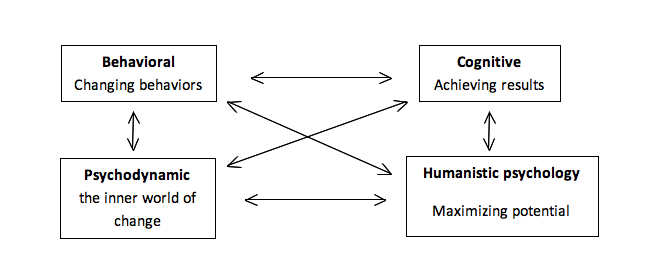Change, the magic word that once heard all leaders hearts tremble in terror.
We as humans are always afraid of change. Why change something that we know and have mastered? So imagine when you have to implement change into a whole cooperate in order to survive the rapid market growth!
I will not be telling you it’s easy or give you a magic process to enable the change transaction but I can place you on the right path. Before we talk about the right way to manage change let us understand first what is change in cooperates.
There are four levels of changes that occur:
1-Individual change: is the heart of everything that is achieved in organizations, but what are the approaches that the individuals go through in change? Well it’s almost simple as below:
2-Team change: without going in the hassle of the definition of team and group, let us first see how many types of teams there are, in general there are nine types of team!
-Group Team: Dependent on nature and composition of group.
-Work Team: Dependent on team members and team culture.
-Parallel Team: Dependent on purpose and team members.
-Project: Theoretically high, good for limited changes in scope but not total.
-Matrix Team: Dependent on degree of enabling or disabling structure.
-Virtual Team: Dependent on purpose and team members.
-Network Team: Dependent on purpose and team members.
-Management Team: Theoretically and practically high, Sometimes will have difficulty adapting to others’ change.
-Change Team: Theoretically and practically high.
See that was easy for teams, right? Well truth is the more types of teams you have the more complex and chaotic it gets so always know how many types of teams you have.
3- Organizational change: according to “Morgan” there are eight organizational metaphors
-Machines
-Organism
-Brains
-Cultures
-Political systems
-Psychic prisons
-Flux and transformation
-Instruments of domination
Here I have selected the four common types we see in the corporate world and crossed them with the models/approaches for organizational change.
| Model or approach | Machine | Political systems | Organism | Flux and transformation |
| Lewin, three-step model | X | X | ||
| Bullock and Batten planned change |
X | |||
| Kotter, eight steps | X | X | X | |
| Beckhard and Harris change formula | X | |||
| Nadler and Tushman congruence model | X | X | ||
| William Bridges, managing the transition | X | X | X | |
| Carnall, change management model | X | X | ||
| Senge, systemic model | X | X | X | |
| Stacey and Shaw, complex | X | X |
The above table helps you in knowing which model/approach to use based on the type of your company instead of adapting an approach and after going thought the hassle to implement it and then realize that it was not the correct model/approach.
So now that you know how individual change will happen, team change and organization type and what model/approach to use, so let’s jump into change! Not yet there is one more final step. You need to get ready for the change itself. And the above does not cover it; it was an aid in the change process itself.
What can we now do to prepare the organization for tackling the change? There are 3 common processes that have been tested and applied in many cooperates and it was successful, the process that you select to adapt is entirely based on your sole judgment.
A- Pfeifer and Schmitt suggested four ‘antecedent processes’ which contribute towards this enabling environment in which change can then occur.
– Chartering: The process by which the organization defines the initiative’s purpose, its scope, and the way people will work with one another on the program.
– Learning: How managers develop, test, and refine ideas through experimentation before full-scale roll-out.
– Mobilizing: The use of symbolism, metaphors and compelling stories to engage hearts as well as minds in order to build commitment to the project.
– Realigning: A series of activities aimed at re-shaping the organizational context, including a redefinition of roles and reporting relationships as well as new approaches to monitoring, measurement and compensation.
B- Sirken, Keenan and Jackson highlighted four key factors surrounding the preparation and general readiness of the organization with respect to a change initiative.
-Duration: ‘a long project that is reviewed frequently is more likely to succeed than a short project that isn’t reviewed frequently’.
– Integrity: ‘the extent to which companies can rely on teams of managers, supervisors, and staff to execute change projects successfully’. This comprises the mix of knowledge, skills and experience needed in getting changes done on time, to budget and the required quality.
– Commitment: the demonstrable willingness of top management, the change team and the recipients of change to be engaged in the change.
– Effort: the effort that is required ‘over and above the usual work that the change initiative demands of people’
C- Balogun and Hope Hailey approach change by asking some very clear questions about the change itself and about what ‘levers’ need to be pulled to implement successful change. They then go on to look at some of the different things you need to consider when planning and managing change, what they call the design choices.
| levers of change | Design choice |
| Time | Change path |
| Scope | Change start point |
| Preservation | Change style |
| Diversity | Change target |
| Capability | Change levers |
| Capacity | Change role |
| Readiness for change | |
| Power |
If and only IF each step of the above is applied correctly you will not face many difficulties in the change process and everyone will be happy when they are embracing change. It is not an easy task to be done nor it can be completed overnight or a few days, It will take time, dedication and hard work to smooth the change transaction.


